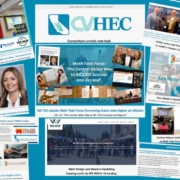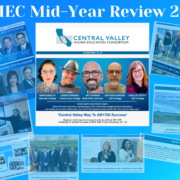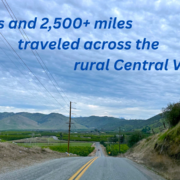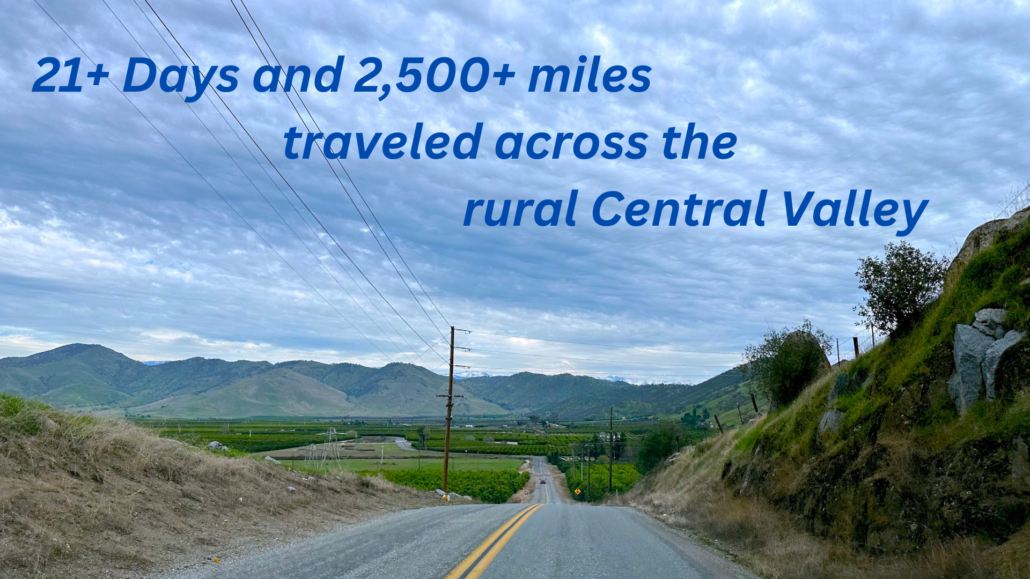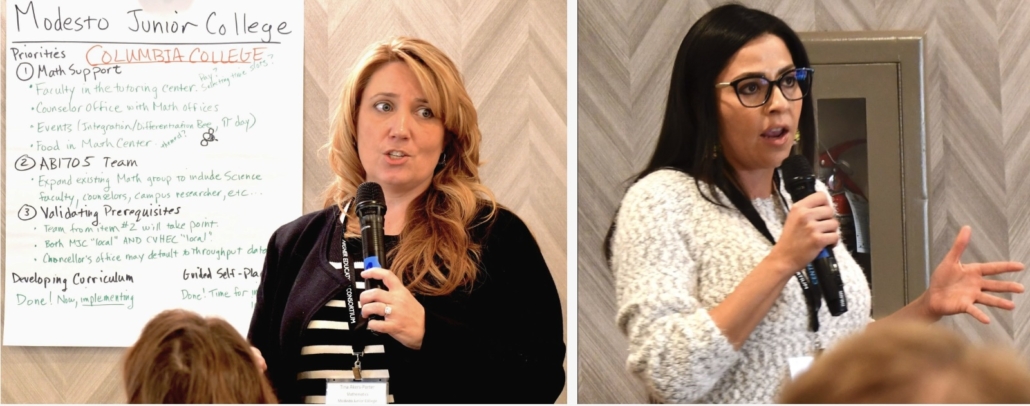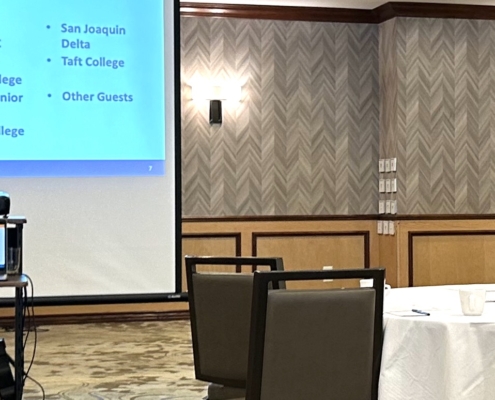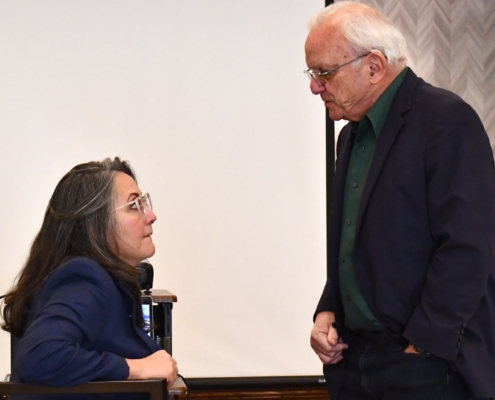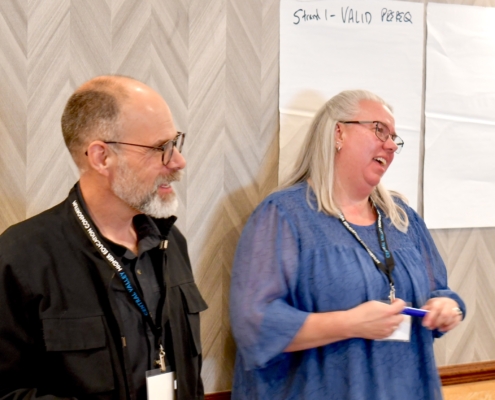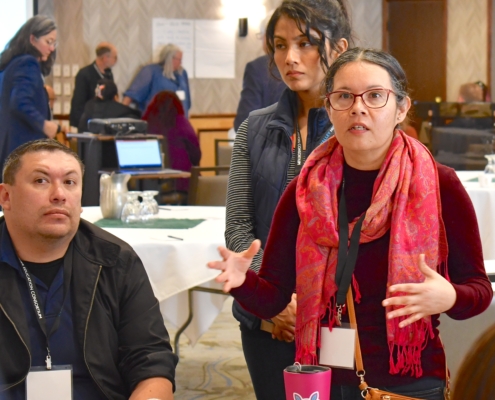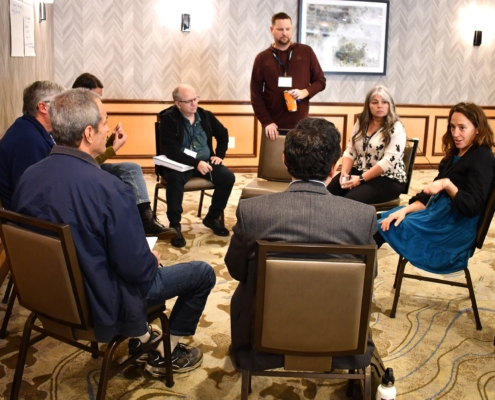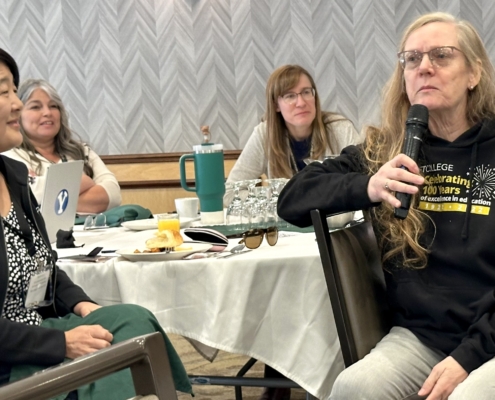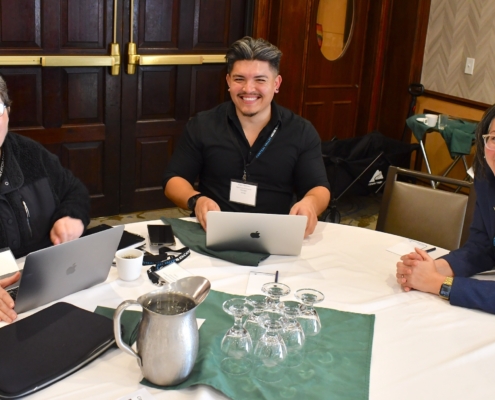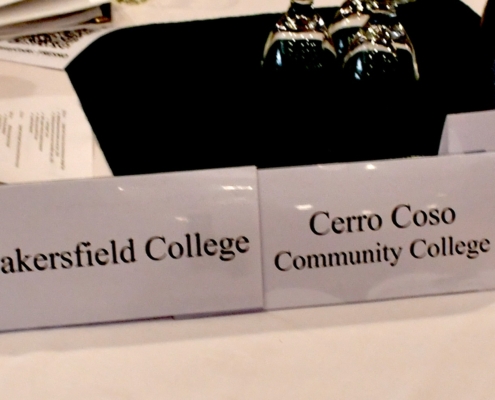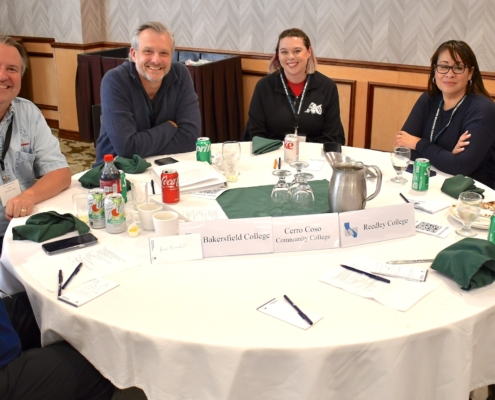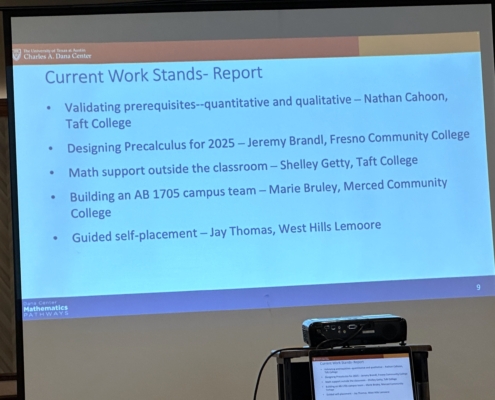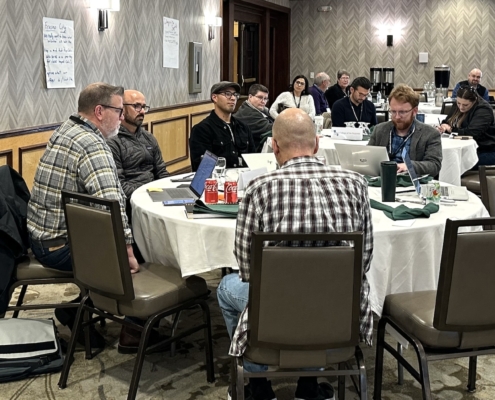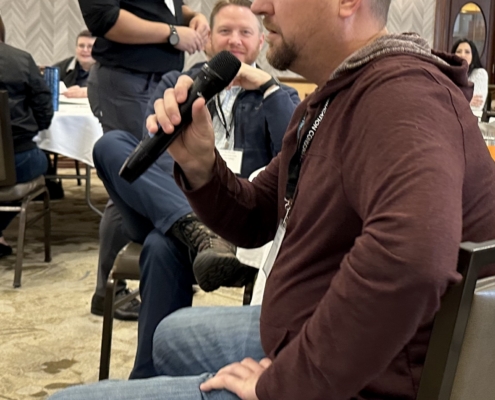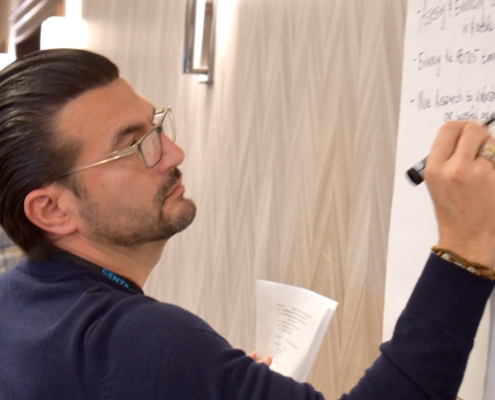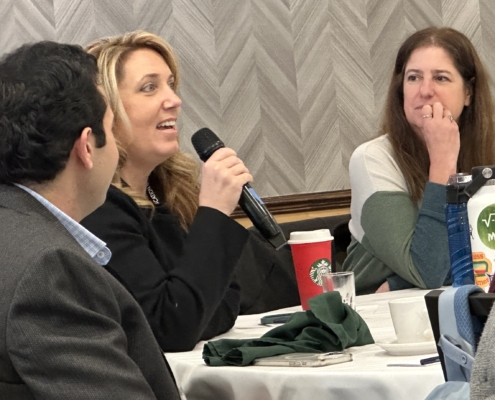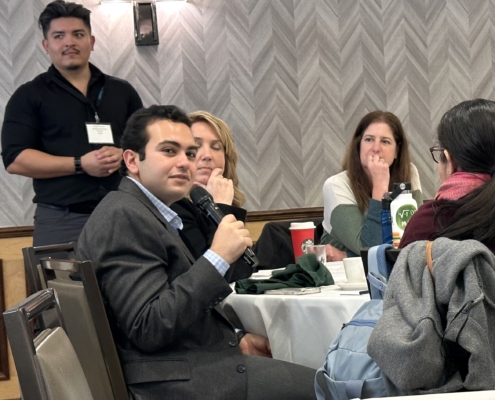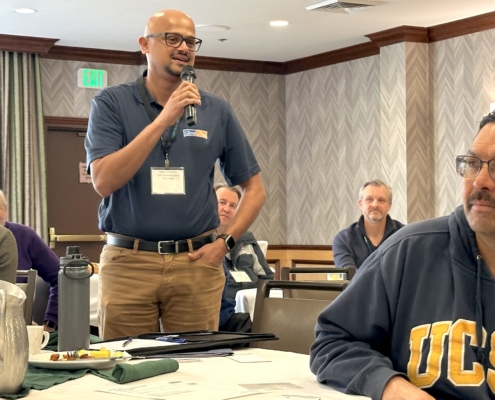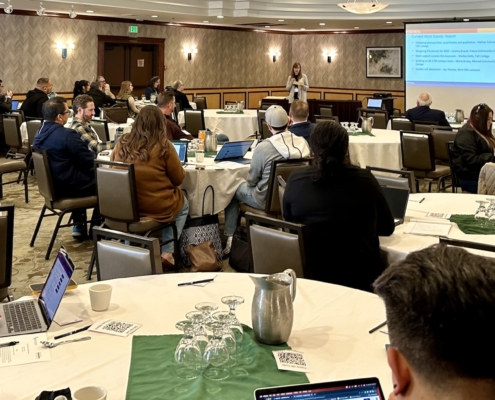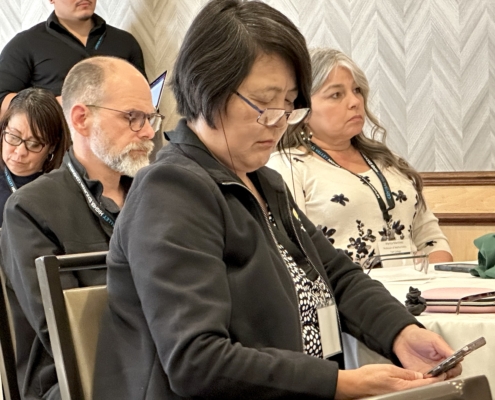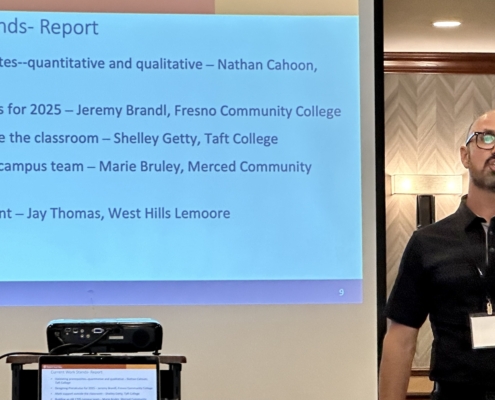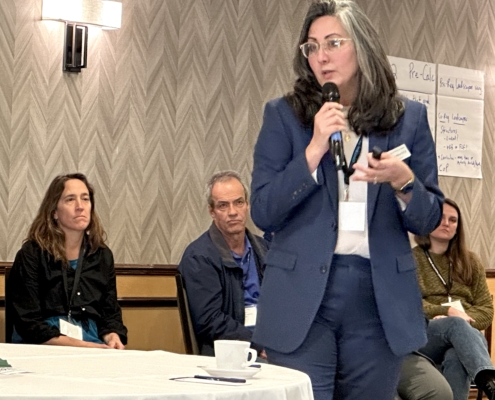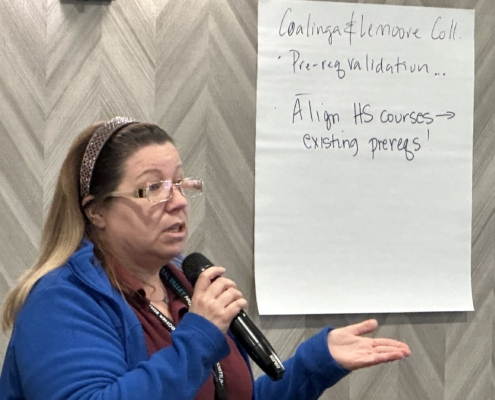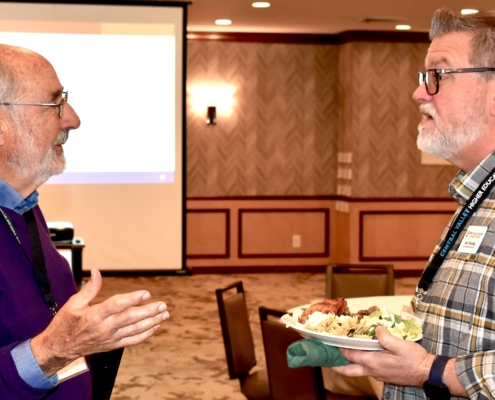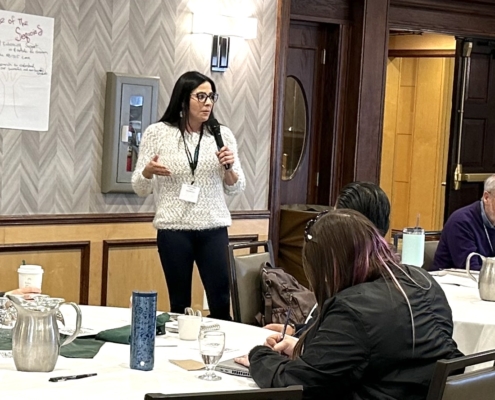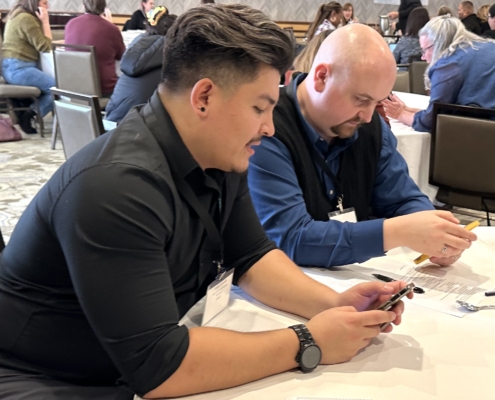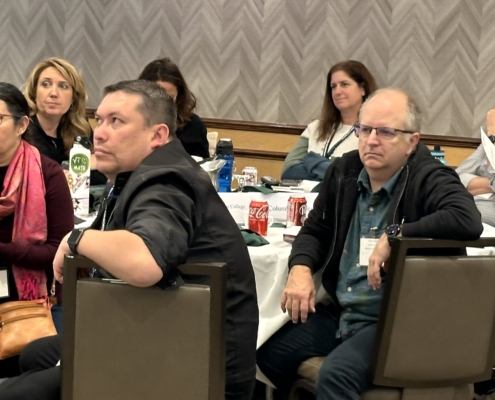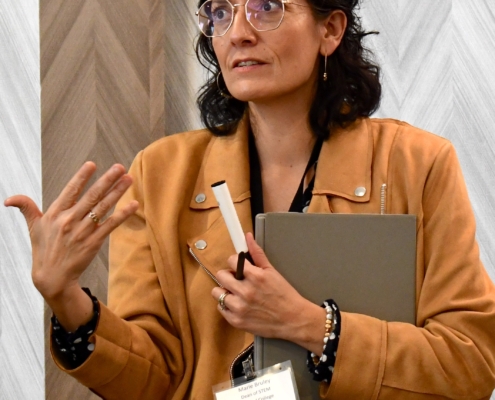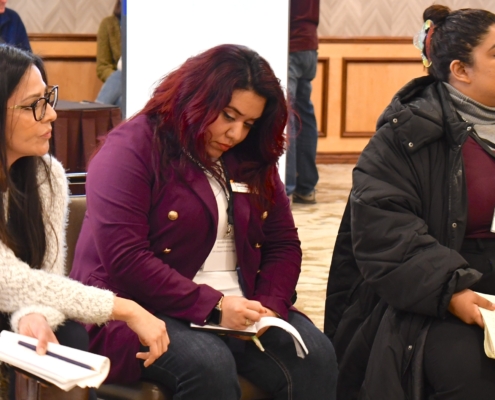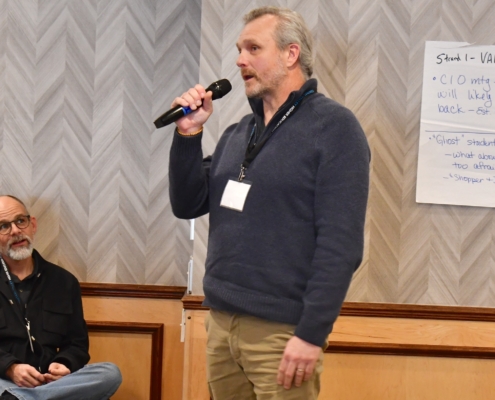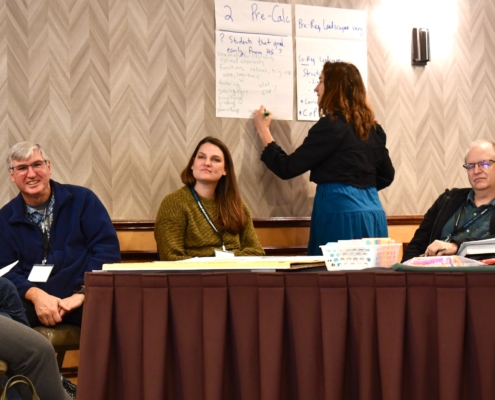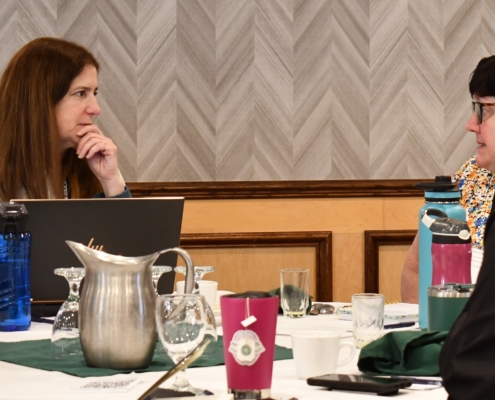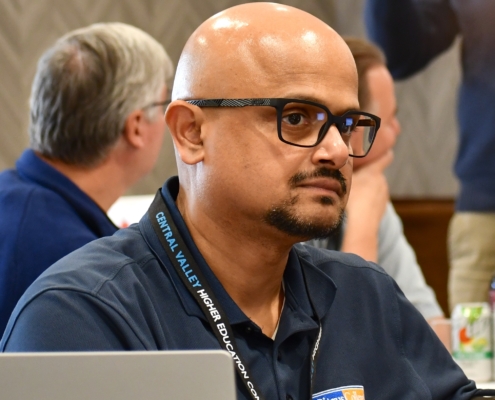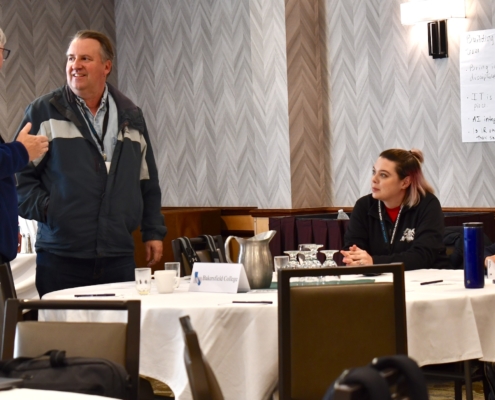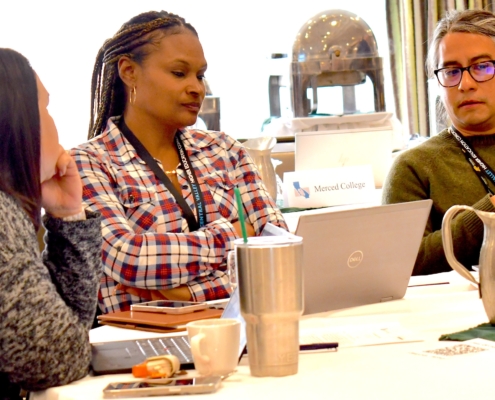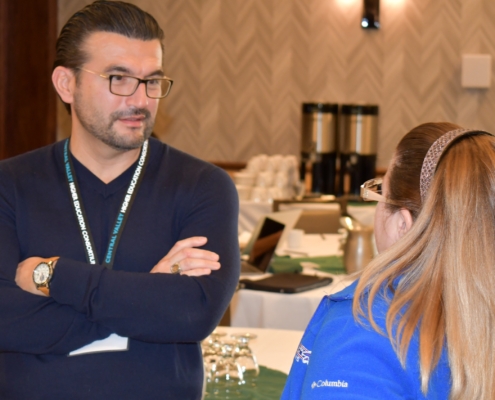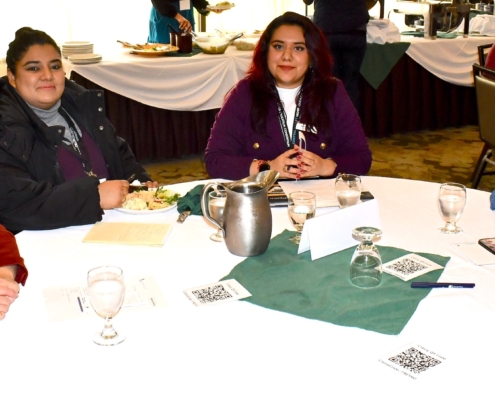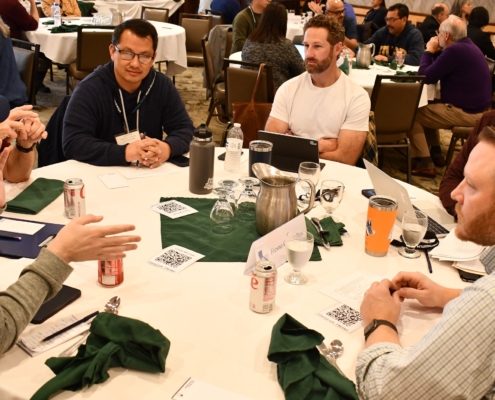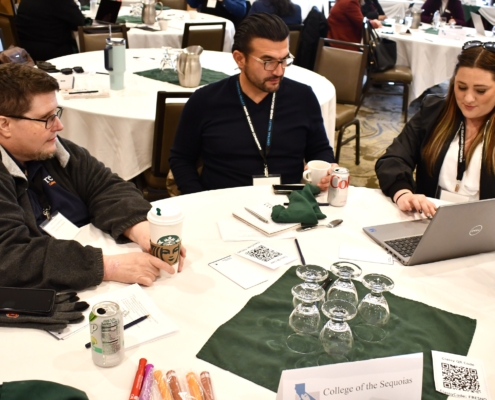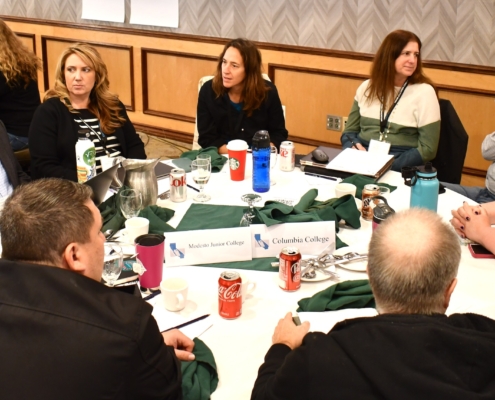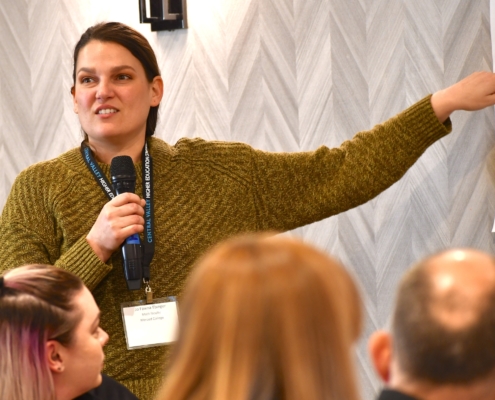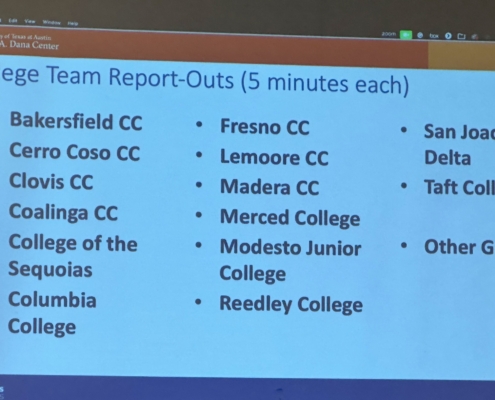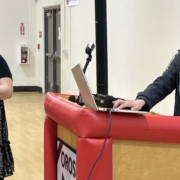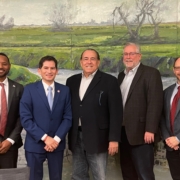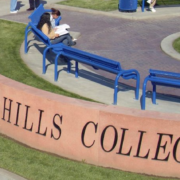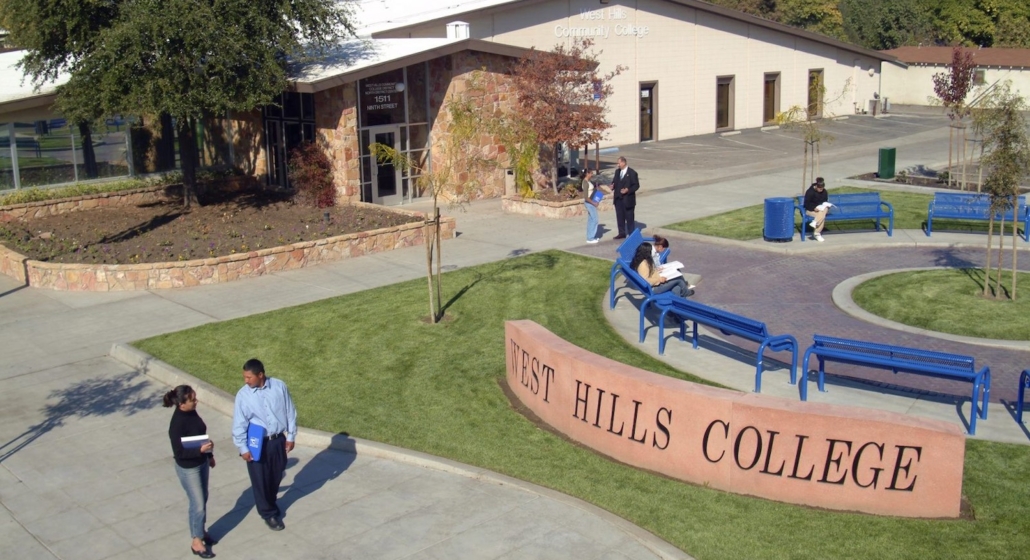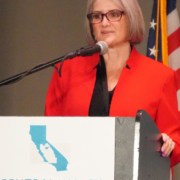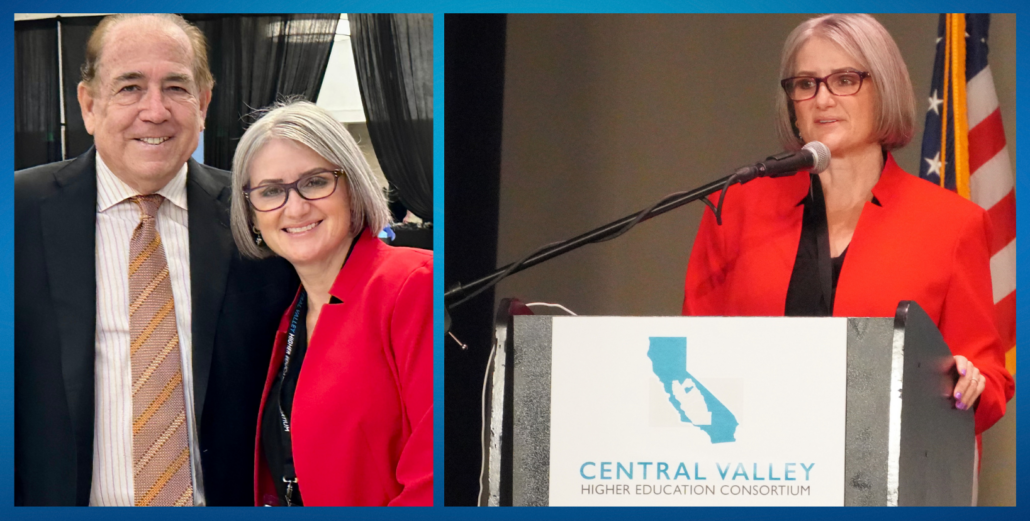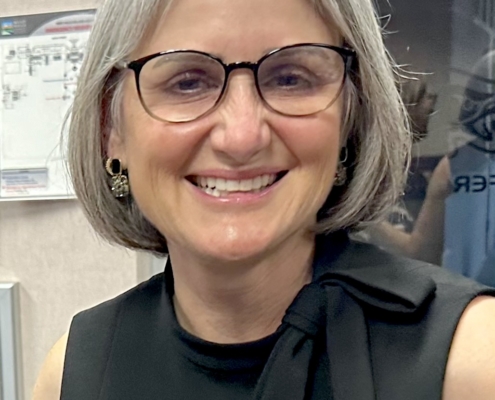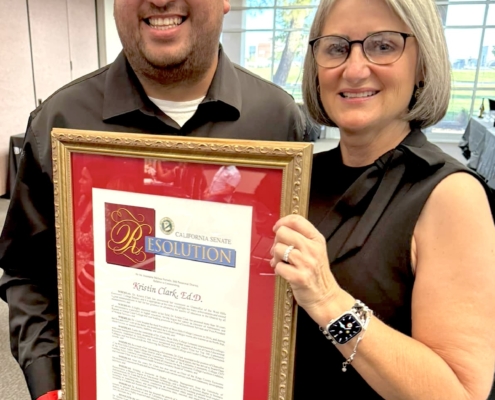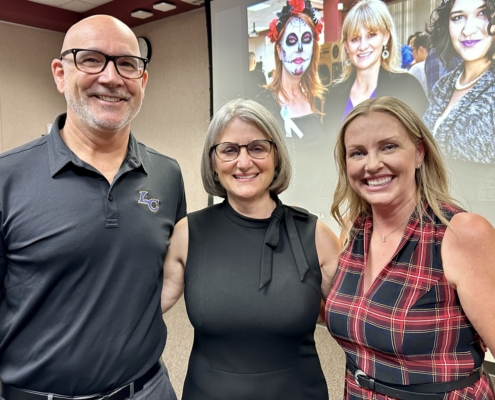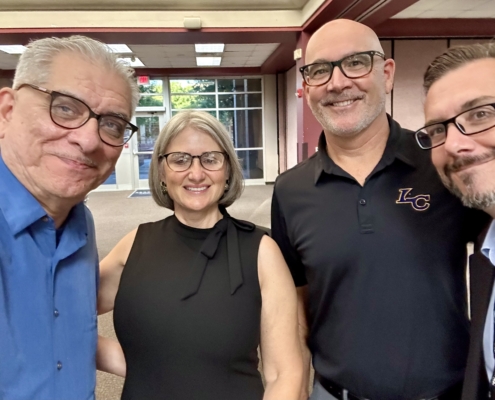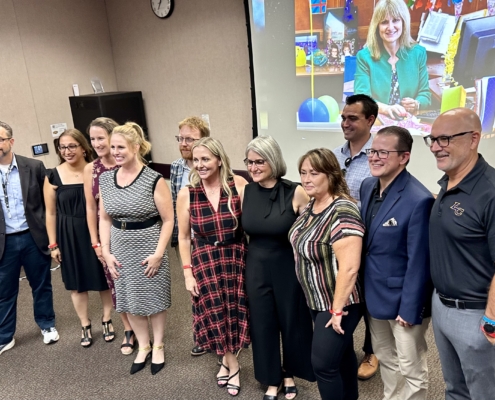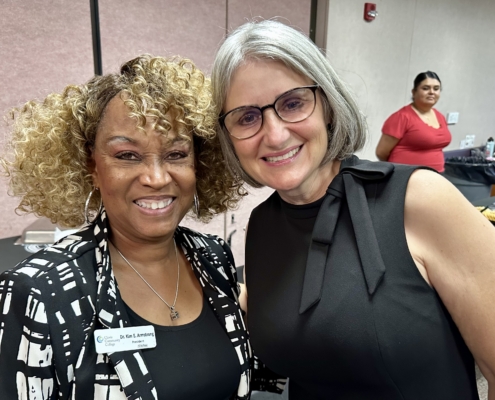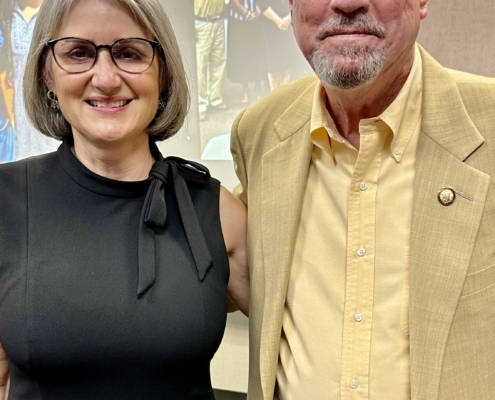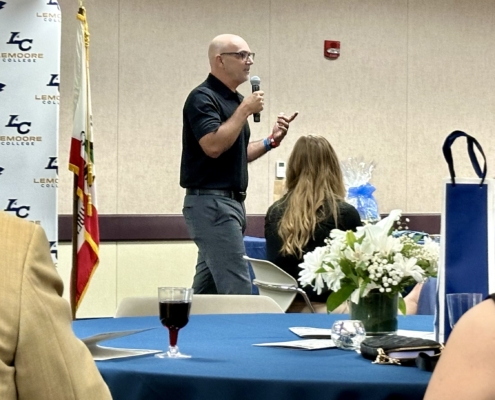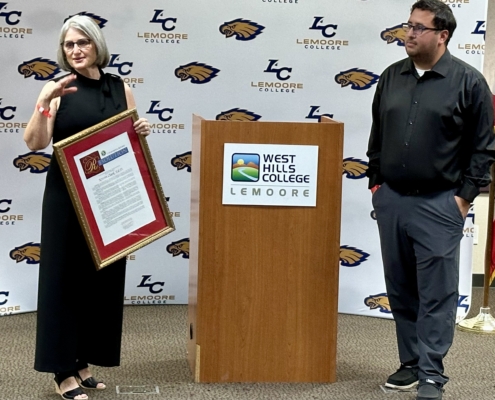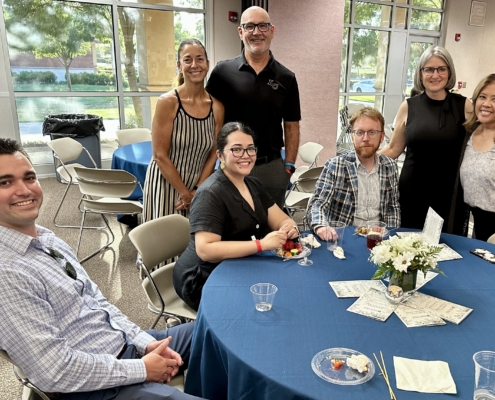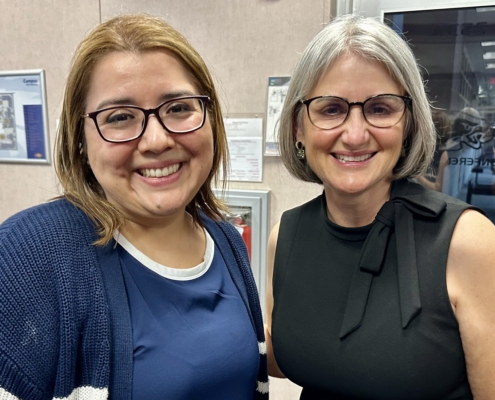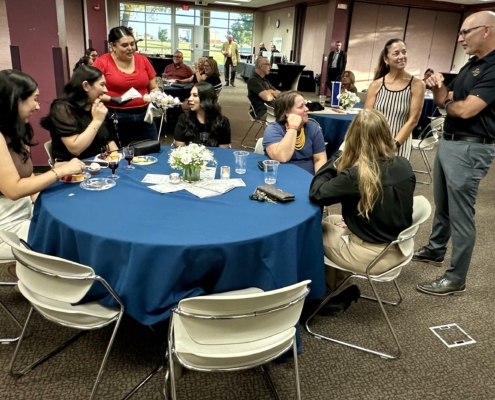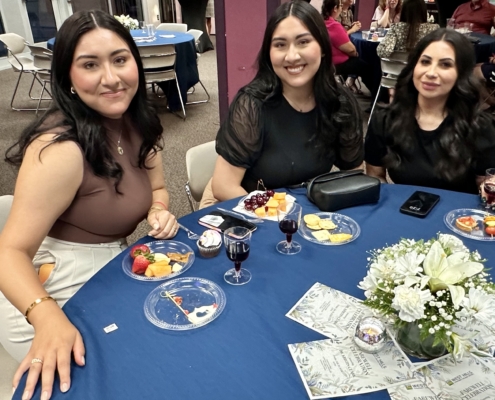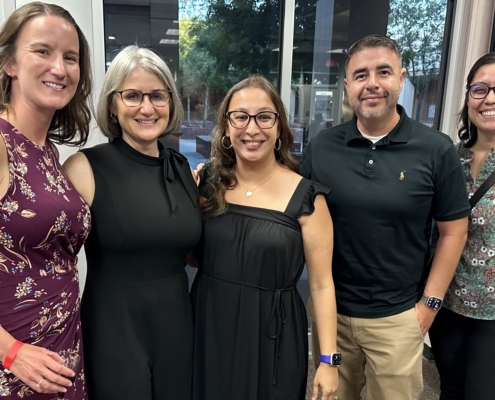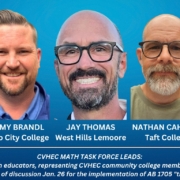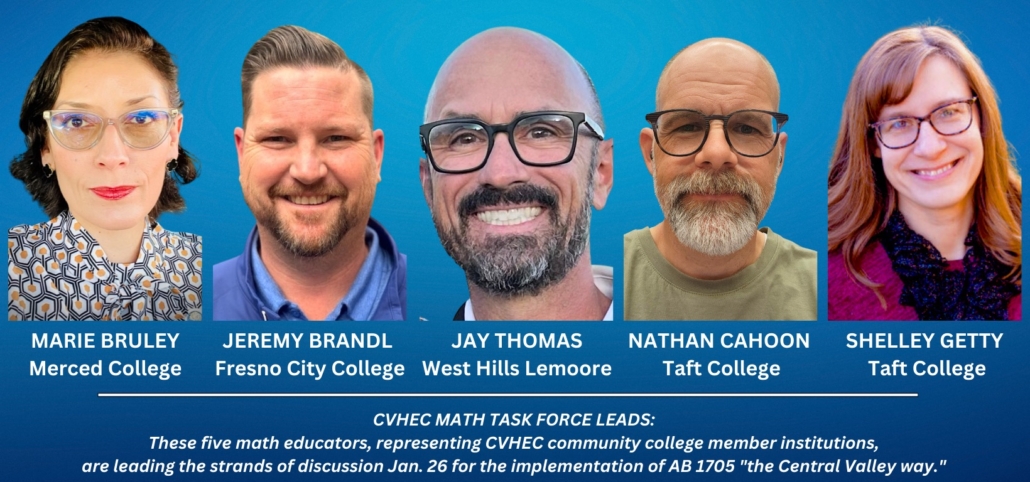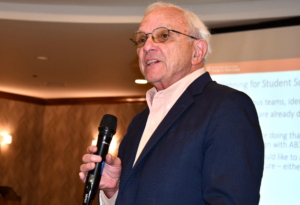MATH BRIDGE UPDATE- April 2024
The road to Orosi, California typifies the rich rural areas of Central California where CVHEC and College Bridge are reaching
out to provide Math Bridge services that help prepare high school students for college. (Tom Uribes photo)
Math Bridge campaign identifies nearly
1,000 students for college-level math courses
BY DR. NICOLE KORGIE
Vice President of Operations – College Bridge
The Central Valley Math Bridge project is off and running as 13 committed high school partners with College Bridge and the Central Valley Higher Education Consortium are completing a student recruitment campaign that has identified nearly 1,000 students ready to take on college math and nearly half of those indicating their interest to participate.
The impact Math Bridge is having on education in the region is seen in one general characteristic of these students: they were likely NOT to have taken an advanced math course, or even math at all, in their senior year.
Now, as more high school students graduate with solid/advanced math skills though Math Bridge, more students will find success in college and career, filling vital local workforce needs.
The participating high schools stretching across the Valley’s nine-county region from Taft to Stockton are partnering with six community college members of CVHEC to offer the math dual enrollment courses at their respective campuses beginning next fall (student breakdown in parenthesis. The community colleges and their participating feeder schools are::
DELTA COLLEGE: Stagg High School, Weber Academy;
MERCED COLLEGE: Atwater High, Buhach Colony High School, Golden Valley High School, Livingston High School, Mariposa High School;
REEDLEY COLLEGE: Dinuba High School, Orosi High School, Sanger High School, Sanger West High School;
TAFT COLLEGE: Taft High School;
WEST HILLS COLLEGE LEMOORE: Riverdale High School.
The campaign: no longer running from math!
The nearly 1,000 Central Valley students from these high schools identified as great prospects to participate in Math Bridge have solid academic GPA’s — between 2.3 – 3.4 — but have struggled in high school math.
Beginning at Taft High School in January, the prospective students were presented with information about Math Bridge and the benefits of participating such as allowing these students to complete a college level math course before they graduate from high school.
While you may think that many if not all students who fear or dislike math would run screaming if presented with the opportunity to take a college level math course, you may now re-think that: of the nearly 1,000 students identified, NEARLY HALF completed a form AFFIRMING their interest in participating in Math Bridge. They expressed a desire to take on the challenge of college level math that the Math Bridge project provides the high school including extensive support to help students pass the course.
For the upcoming academic year, all Math Bridge partner sites will offer a statistics course though their local community college. Math Bridge will be working with the college faculty and high school math teacher at each site to ensure that appropriate support services are provided to the students in the course.
We are currently following up with the 500 students who completed the interest form in the recruitment sessions to ensure that they meet with their school counselor to confirm that Math Bridge is the correct option for them for senior year and their post-secondary goals.
To date, 230 students have signed up. And we’re not done yet as Dinuba and Stagg have yet to begin their student recruitment process so even more students will be given this opportunity by the time we provide a final enrollment number in a future update.
Prepping participant high schools for Math Bridge
As this student recruitment campaign wraps up this spring, we now move into the support phase for the educators from the high school participants with a special event May 3 in Fresno to help prepare teachers for the Math Bridge project’s launch in the fall semester.
On that day, College Bridge will host our Math Bridge Instructional Planning Meeting where college and high school math instructors and their support teams (math coaches, chairs, supporting faculty) will collaborate with our project team around the who, how, when, where and what for the Math Bridge courses to be taught in Academic Year 2024-2025.
Activities for the day will include reviewing curriculum, assessments and commonalities between college courses and any necessary local differences. We will also review the requirements for instructors to earn the project stipend as well as calendaring all future planning and collaboration times per college service area.
It is understandable that some feel the slight mention of math is enough to squash any conversation but the groundbreaking role these Central Valley high schools and their community college partners are taking on with College Bridge and CVHEC is a new level of excitement for educators seeking to arm their students for a successful higher education experience.
BACKGROUND: College Bridge’s mission is to identify and eliminate barriers that prevent underrepresented students from progressing to and through college specifically focusing on Black, Latino, low-income and rural students. One of its two objectives is to expand strategic dual enrollment partnerships to serve low-income, rural and Latino students in California’s Central Valley. In December 2022, College Bridge was awarded a five-year $4 million US Department of Education grant for the Dual Enrollment Math Bridge Project so six CVHEC community colleges could provide college-level math classes that will improve and support college readiness for underprepared students in the colleges’ respective service areas. In April 2023, the project received a $1,075,340 award from the California Regional K-16 Education Collaboratives Grant Program through two Central Valley K-16 programs – the Fresno-Madera K-16 Collaborative and the Tulare-Kings College & Career Collaborative. Then in December 2023, a $2,196,928 federal grant was awarded for expansion of the College Transition Bridge project that, among other features, will advance collaboration with CVHEC’s Central Valley Transfer Project and its college course-planning software, Program Pathway Mapper, as well as with consortium member colleges.
MATH TASK FORCE: ‘Something extraordinary’ (Jan. 26 wrap)
Modesto Junior College math professor Tina Akers-Porter discusses her strand group’s deliberations at “The Central Valley Way to AB1705 Success” Convening Jan. 26 where a call for a “principals task force” by Orosi High School Principal Marlena Celaya would bring more secondary education voices to the table.
‘Something extraordinary is happening in math in California’s Central Valley’
Math Task Force latest AB1705 session leads to calls
for more data, high school input, re-convene April 19
BY TOM URIBES
CVHEC Media/Communications Coordinator
Realizing that state guidance surrounding Assembly Bill 1705 remains elusive, valley community college math educators and officials forged ahead at “The Central Valley Way to AB1705 Success” convening Jan. 26 in Fresno with a determined and unified mindset to develop implementation plans that will serve the best interests of their students including a follow-up session set for April.
In addition, the Central Valley Higher Education Consortium (CVHEC) Math Task Force discussion centered around five strands of curriculum planning for implementation before the law goes into effect July 1, two aspects emerged at the lively day-long work session: the increased participation of institutional researchers for pertinent data-collecting and a call for a “principal’s task force” to bring upper secondary education voices to the table.
Presented by CVHEC, the convening — the latest in a series of deliberations since fall — was attended by 82 representatives from the consortium’s 19-member community colleges, one high school principal and campus research professionals.
They agreed to reconvene April 19 for reports on follow-up work that will occur as a result of this most recent event. Registration for that event will open next month with additional details forthcoming.
Facilitated by the Charles A. Dana Center at the University of Texas at Austin, the session last month reviewed five strands of curriculum planning: Validating Prerequisites; Designing Precalculus for 2025; Math Support Outside and Inside the Classroom; Building an AB 1705 Campus Team; and Guided Self-Placement.
“With tensions high and little guidance surrounding AB1705, the 19 community colleges and districts that comprise the CVHEC nine-county region are rolling up their sleeves and getting to work on this math movement the ‘Central Valley Way’,” summarized Tammi Perez-Rice of the Dana Center.
Perez-Rice, who co-facilitated the event, said the convening was solely dedicated to working and planning at a regional and institutional level in two parts. The first part was dedicated to expanding the five work groups that emerged from the Nov. 17 webinar and creating a plan to move forward. The second half of the convening was devoted to institutional planning.
“The fruits produced from these convenings are already being felt around the region,” Perez-Rice said. “The plans and implementations emerging from these convenings are more than just a response to AB705 and AB1705; they cultivate systemic reforms that will benefit all students in the CVHEC region and beyond.”
John Spevak, CVHEC regional coordinator who oversees the consortium’s Math Task Force and co-facilitator of the Jan. 26 gathering, said in the short-term, the five strands work groups will continue to communicate and provide updates in preparation for the April 19 convening. The strand leads are preparing summaries of their Jan. 26 breakout discussions and member college teams are preparing summaries of the tentative plans they developed in the afternoon breakout sessions for oral reports in April.
“In the longer term, our Math Task Force will continue to monitor what the California Community College Chancellor’s Office says, while mainly going forward with our own Central Valley approach to the five strands.”
That “Central Valley Way” stems from the work undertaken by the CVHEC Math task Force, first formed in 2019, in the past year that was intensified with four work sessions beginning Oct. 6 in a virtual convening with CCC vice-chancellor Eric Cooper. The first in-person session followed Oct. 13 in Fresno and another virtual session was held in two parts Nov. 17 before the Jan. 26 session.
These sessions may represent the only concerted effort by a region’s community college math community actively meeting to collaborate across campus boundaries for ways to unite as one voice and determine a curriculum course of action that meets the law’s intent, Spevak said.
“We at CVHEC, along with the Dana Center representatives and our College Bridge partners in the Math Bridge Program, feel that something extraordinary is happening in math in the Central Valley of California,” Spevak said.
After the Jan. 26 session ended, Perez-Rice reiterated a point she made the first time she visited Fresno for the first in-person convening last fall:
“This collaboration today was amazing. As I travel and talk to math faculty all over the country, what I see pulsating from the CVHEC community here in Central California is just compassion; caring about their students; putting their students first; understanding what their students need; and more importantly collaborating with each other working across institutions to make things happen.”
Inviting secondary ed voices to ‘align syllabi’
A key development of the convening was the assertion and agreement that a crucial next step is “to involve high schools in the discussion and determine how to breakdown barriers between systems for a cohesive collaborative effort to put students first across the state of California,” a message delivered by Marlena Celaya, principal of Orosi High School who was the only secondary education official in attendance.
Celaya’s comments, first in a strand session and later in general comments before the assembled group, resonated with the community college professionals as she offered to lead a task force of principals/administrators who would unify with the CVHEC community college math educators for implementation strategy — to listen and hear what the needs are and how to meet those needs.
“I’m willing to lead this work because I don’t want people to go through the wars I went through teaching algebra and volunteering all my time,” said Celaya, a former math teacher at Dinuba High School. “We would want to hear from community colleges and say to them ‘what do you need?’
“We heard something from you today: ‘I want to know what courses are offered at the high school and what does that course description look like?’ Aligning syllabi is what I’d like to do,” Celaya said. “Mathematics is my passion.”
Perez-Rice said the April 19 convening promises more high school representation, with over twelve principals who are part of the Math Bridge Program by CVHEC and College Bridge being invited. Other secondary education officials from throughout the valley are welcome she said.
Participant feedback: ‘great to see we’re not alone in this …’
After the event, several participants shared their assessment of the Jan. 26 convening.
“The conversations were amazing and we really appreciated being here,” said Joshua Lewis, chair of the Bakersfield College Mathematics Dept.
“There have been so many legislative changes and so many unknowns it’s nice to see the work that other campuses are doing and realize that we’re not alone, that we have shared values; that we have shared emphasis on student learning and really care about doing right by all of our students,” he added.
Nathan Cahoon, Taft college math professor, felt that the efforts of CVHEC’s Math Task Force as exhibited at the convening is strengthening the voice of the valley’s math community which will have an impact.
“It was amazing to work with incredible professionals who have some really amazing ideas,” he said. “I know I took many good notes about ideas to implement at our college. The connections we are building here with each other will be powerful down the road as we build a cohesive effort to get some good research together that we can send to the state as one voice from all the colleges.”
Modesto Junior College math professor Marina Hernandez said coming together within the region is relished because when attending other statewide or national conferences, the focus is not as localized.
“It was very helpful to learn what other colleges in the Central Valley are doing because we share similar student population and resources characteristics and their best practices are applicable to us here in our region,” Hernandez said.
Tina Akers-Porter, Modesto Junior College math professor, said the Math Task Force work has helped her better understand what AB1705 is and what it means for her students.
“I feel like I have a better understanding of some of the challenges of the legislation and what others are worried about,” she said. “We share some of those worries but it’s great to hear different points of view on that. A byproduct of this is we are seeing how we need to support underprepared students more, inside and outside the classroom, and sharing ideas to do that.”
Shelly Getty, Taft college math faculty and a strand leader, echoed Akers-Porter: “We left knowing we are going to start some specific tutoring and targeting students for tutoring. We will try to advertise it better and recruit so students get more access to the services we already provide which will greatly impact them. We shared some good ideas on how to do that effectively.”
Marissa Martinez, Taft college math professor, said, “We have our work cut out for us. There’s a lot of things that we have to address with a lot of moving parts. Everything keeps changing but it was great to be able to see that we’re not alone in this, that we’re working together to better serve our students.”
She said this intercollegial collaboration and the feedback from the colleges helps “so we don’t have to reinvent the wheel — what worked, what didn’t work.”
Next steps? Data research
“I would say the next step is collecting our data to see how the numbers show where we are so we can prove that these courses are important for our student success,” Martinez said.
This data aspect was also a key part of the convening as institutional research professionals were invited and directly participated such as Arooj Rizvi, research analyst in the Office of Institutional research and Effectiveness at San Joaquin Delta College.
“Researchers have a monumental role in the implementation of AB 1705 because policymakers are going to depend a lot on what we are able to produce as a group or even as an institution,” Rizvi said. “Being a part of these conversations helps us to see the bigger picture, the context and the requirements of what exactly it is that we are looking for in the data.”
She said it was exciting to hear at the convening what area colleges are going through.
“I realized how similar our challenges are from institution to institution, “she said. “Working through that together and being solution-oriented is something that’s going to take all of us towards a beneficial direction. Seeing us all here today was a defining moment in history.”
Owynn Lancaster, vice president of academic strategy for CVHEC partner College Bridge, said the event was “a huge success seeing folks come together from math to talk about math and really pool their resources to address actual challenges.
“The most powerful focus of change in education is always the educator,” Lancaster said. “I know everything’s heaped on them but in a lot of ways they have the greatest power of the greatest agency for this.”
For more info: centralvalleyhec@gmail.com
For CVHEC media inquiries: Tom Uribes – cvheccommunications@mail.fresnostate.edu (or text 559.348.3278).
See also:
https://bit.ly/MTFconveneKSEE24
Valley’s math ed experts unite to address AB 1705 challenge for student success
The CVHEC Way to Math Success — Implementing AB1705
Math Task Force begins discussion of AB1705 implementation – Nov. 17 next
CVHEC Math Task Force meets in-person Oct. 13 for AB 1705 follow-up
NEWS RELEASE – CVHEC Math Task Force: Impactful legislation (AB 1705) Convenings Oct. 6 & 13
CVHEC Website Feature: Math Task Force Page
PHOTO GALLERY
Central Valley Transfer Project: valley’s four-year colleges collaborating
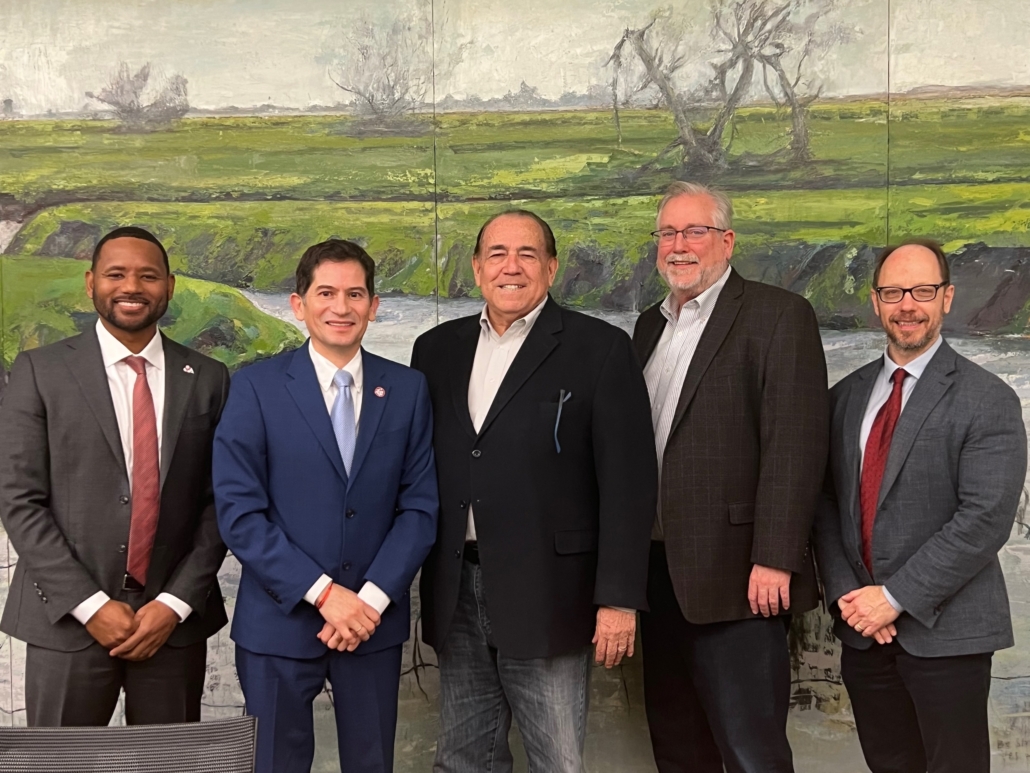
Fresno State, a founding CVHEC member, joined CVHEC’s historic Central Valley Transfer Project in January with (from left): Dr. Kent Willis, vice president of Fresno State Student Affairs and Enrollment Management; University President Saúl Jiménez-Sandoval; Dr. Benjamin Duran, CVHEC executive director; Tom Burke, CVHEC regional coordinator; and Dr. Sergio La Porta, associate dean of the Fresno State College of Arts and Humanities.
Fresno State joins in transfer ‘centerpiece’ with
11 CVHEC community colleges, 3 CSUs, UCMerced
The Central Valley Transfer Project is now partnered with the region’s three California State University campuses after Fresno State signed on in January joining Bakersfield and Stanislaus in the historic Central Valley Higher Education Consortium initiative designed to open new doors for students’ successful transfer from community college.
Along with founding partner University of California, Merced, this means the valley’s four public institutions of higher education are working in unison with 8 community colleges currently through CVHEC’s project using the groundbreaking Program Pathways Mapper software. The project has also gained the full support of the California Community College Chancellor’s Office.
The community colleges already in the CVTP, with several more expected to sign on this year, are: Bakersfield College, Clovis Community College, Madera Community College, Merced College, Porterville College, Reedley College, West Hills College-Coalinga and West Hills College-Lemoore.
The Transfer Project is also expanding participation in the north end of the Central Valley with Modesto Junior College, Columbia College and San Joaquin Delta College scheduled to begin onboard this spring for a total of 11 community college partners said Stan Carrizosa, CVHEC regional coordinator and consortium lead for the project.
All Transfer Project partners are members of the consortium with their respective chancellors and presidents serving on the CVHEC Board of Directors.
“The Transfer Project is now a centerpiece for students to both enter and transfer from community college to their four-year universities,” said Dr. Benjamín Durán, CVHEC executive director. “We are excited to share this latest progress of the project which has been featured statewide and nationally at conferences such as the Community College League of California and Complete College America.”
He added, “This innovative approach is the only one in the state that includes a University of California campus collaborating with partner California State University and community colleges in establishing transfer pathways for Central Valley students to get them to and through college in a timely manner.”
Dr. Saúl Jiménez-Sandoval, Fresno State president and CVHEC board member, said, “I’m proud that Fresno State will be a dynamic partner in the Central Valley Transfer Project, as this pathway will empower community college students to become visionary Bulldogs.”
The Fresno State agreement was finalized Jan. 17 between Durán and President Jiménez-Sandoval, with Tom Burke, CVHEC regional coordinator and Transfer Project team member; Dr. Kent Willis, vice president of Enrollment Services; and Dr. Sergio LaPorta, associate dean of the College of Arts and Humanities.
At CVHEC’s Higher Education Summit last fall, CCC Chancellor Sonya Christian announced that the statewide system has designated the Transfer Project as a demonstration project as set forth in her Vision 2030 for all California community colleges. The Transfer Project’s participating community colleges are serving as the pilot campuses with plans to implement statewide.
Carrizosa said the state budget continues to support and fund the onboarding costs for all community colleges to subscribe to the Program Pathways Mapper.
Established in 2021 with UC Merced, Merced College and Bakersfield College, the project is designed to open new doors for students to successfully transfer from community college with its Program Pathways Mapper, Carrizosa said.
He said the Program Pathways Mapper — a public facing, internet-based app that can be downloaded and accessed by the public software platform — provides unprecedented ease of access for students, counselors, advisors and parents much more so than other existing platforms.
“There are no typical requirements for access to PPM such as other internal college systems like Degree Works, Assist.Org and the CSU Transfer Planner,” he said. “These are all course tracking systems but in order to use them, students need to be successfully enrolled in college and have a student email address or other form of login to try and plan. Through PPM students simply upload the public PPM app to their devices and have immediate access.”
Carrizosa said the PPM helps simplify the transfer planning process which can be the most difficult task for many students.
“In much of our Central Valley region, as many as seven out of 10 incoming college freshmen will be first generation students to attend college,” he said. “Research shows that the most difficult task for them is often the application process itself and completing the required steps for enrollment. Systems like Degree Works and others do nothing to remove this common barrier because these systems cannot be accessed until a student successfully enrolls.”
He explained that a high school student can start the Transfer Project journey as a junior or senior by enrolling in college dual enrollment courses enabling them to complete their transfer level English and Math courses while still in high school. These units roll up with them as they enter community college and track the completion of their lower division requirements for their Associate Degree for Transfer in their chosen major via PPM.
“Students can easily select a community college they wish to attend and a major they want to pursue and the lower division courses required are sequentially laid out for them through the Program Pathways Mapper software.”
In addition, the PPM then links those lower division courses to an upper division institution of the student’s choice and shows a clear sequence of upper division courses needed to complete the degree, Carrizosa added.
“The PPM contains clear and accurate information directly from course catalogues from all participating colleges,” Carrizosa said. “The Central Valley Transfer Project is becoming an alternative continuum of courses to the traditional high school A-G or Career Technical Education continuums and is unprecedented in the state’s community college system. We call it ‘The Central Valley Way!’”
“Through the use of PPM, students complete exactly what is required of them to successfully transfer to their four-year university and they follow PPM through their last two years to degree/certificate completion,” Carrizosa said.
Baseline data results also demonstrate the promise that PPM delivers in the Transfer Project.
In a sample of 5,000 incoming freshmen to Bakersfield College in 2022 the students using the PPM increased their “percentage of on-path course completion” to over 80 percent which also closed the equity gap in this statistic for ethnic minority students when compared to their white counterparts, Carrizosa said.
“The same sample showed students using the PPM reduced the ‘number of units-to-degree’ from an average of 87 down to 67,” he added.
The project is now gearing up to expand the partnership with the College Bridge Math Project and to onboard community colleges from the northern region of the Central Valley.
For more information about the CVTP, contact Carrizosa at centralvalleyhec@gmail.com.
CVHEC media inquiries: Tom Uribes – cvheccommunications@mail.fresnostate.edu or text 559.348.3278.
Fresno State media inquiries: PIO Lisa Bell – lbell@csufresno.edu.
See:
· Pilot CVHEC/UC Merced Transfer Project improves process for students
· CVHEC Web Site Feature: Transfer Project
· Historic Transfer Project spurs statewide movement to increase transfer rates
· HIGHER ED NEWS: College Bridge to expand Math Bridge; CVHEC Transfer Project
• A-G
MEMBER NEWS: WHCCD gets federal grant for RuBICON – rural broadband
$1 million USDA grant awarded to West Hills CCD
for broadband cooperative formation
Project director recruitment underway
The West Hills Community College District (WHCCD) has received a $1 million federal grant that will play a pivotal role in establishing the Rural Broadband Initiative Cooperative Network (RuBICON), a project aimed at providing affordable broadband services to rural communities and farms in the Central Valley.
The district, a Central Valley Higher Education Consortium (CVHEC) institution member, announced the United States Department of Agriculture (USDA) award Feb. 21 as well as a search for a project director for RuBICON, which aims to empower local communities by forming a cooperative that delivers reliable and cost-effective broadband access, bridging the digital divide in the rural Central Valley.
The district said this groundbreaking endeavor draws inspiration from the historic electric co-op movement, envisioning equitable change and progress for rural America in the 21st century.
Jeff Seed, WHCCD associate vice chancellor of Information Technology, emphasized the broader impact of this grant, stating, “This is not just about broadband access – it’s about fostering sustainable farming, building robust local economies, and empowering our rural communities for the digital future.”
In a social media post, Chancellor Kristen Clark, who is also CVHEC Board of Directors chair, said, “Excited about this opportunity for the West Hills Community College District to help support high-speed broadband on the Westside of the Central Valley.”
Project RuBICON has garnered support from a diverse coalition of partners committed to assessing and delivering connectivity to rural communities in the Central Valley. The initiative will collect comprehensive data to understand current needs and identify solutions to address connectivity gaps. In addition to infrastructure development, West Hills will offer digital literacy education for local communities and leverage its Farm of the Future to create a framework for agricultural technologists, propelling the community toward Agriculture 4.0.
“This project is designed to facilitate cost-effective broadband deployment, with the goal of serving as a model that can be replicated across the country,” Seed added.
For WHCCD media inquiries, contact Amber Myrick at 559.934.2132 or ambermyrick@whccd.edu.
See:
CVHEC BOARD NEWS: Retirement of WHCCD Chancellor Clark – STATEMENT
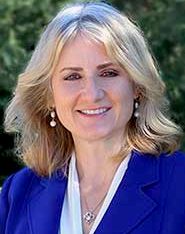 The West Hills Community College District (WHCCD), announced today the retirement of Chancellor Dr. Kristin Clark effective July 2024. For the past two years, Chancellor Clark has served as chair of the Central Valley Higher Education Consortium Board of Directors, which is made up of the chancellors, presidents and campus directors of 28 institutions of higher education in the region’s nine-county area. She also served on the board during her term as president of West Hills College Lemoore prior to the WHCCD chancellorship. The West Hills Community College District will soon initiate a search for a new chancellor. Dr. Benjamín Durán, CVHEC executive director, issued the following statement.
The West Hills Community College District (WHCCD), announced today the retirement of Chancellor Dr. Kristin Clark effective July 2024. For the past two years, Chancellor Clark has served as chair of the Central Valley Higher Education Consortium Board of Directors, which is made up of the chancellors, presidents and campus directors of 28 institutions of higher education in the region’s nine-county area. She also served on the board during her term as president of West Hills College Lemoore prior to the WHCCD chancellorship. The West Hills Community College District will soon initiate a search for a new chancellor. Dr. Benjamín Durán, CVHEC executive director, issued the following statement.
Dr. Benjamín Durán, CVHEC executive director, and WHCCD Chancellor Kristin Clark at the Central Valley Higher Education Summit October 19, 2023 where she delivered the welcome address.
UPDATE July 26, 2024: Chancellor Clark honored at farewell reception (see photo gallery below).
STATEMENT
Chancellor Clark: a champion
of higher education for all
We at the Central Valley Higher Education Consortium along with so many others in the region and the state, are experiencing mixed feelings with Chancellor Kristin Clark’s announcement of her retirement effective the end of this academic year.
We are happy for Chancellor Clark as she completes a stellar academic career this spring in preparation for her retirement but at the same time we are saddened that the Central Valley region is losing a leader of her caliber. As the chair of the 28-member CVHEC Board of Directors the last two years, Chancellor Clark has been a champion of higher education for all and certainly for the initiatives and projects the Consortium has undertaken. She has been instrumental in building our network of Central Valley college and university leaders to speak in a single voice on higher education policy issues.
Additionally, Chancellor Clark is recognized throughout the state as the leader of one of the most innovative and student-centered multi-college districts in rural California. The West Hills Community College District and the communities it serves have been fortunate to receive her professional and personal leadership.
Please join us in wishing Dr. Clark all the best, as she gets ready to explore the next phase of her life. Well done, Kristin!
Benjamín Durán, Ed.D.
Executive Director – The Central Valley Higher Education Consortium
President-emeritus – Merced College
See the WHCCD retirement announcement press release.
Bio – Chancellor Kristin Clark
Chancellor Clark Farewell Reception – CVHEC photo gallery:
Valley’s math ed experts unite to address AB 1705 challenge for student success
Math Task Force Convening Jan. 26:
‘Central Valley Way To AB1705 Success’
With the agenda released this week, over 60 Central Valley math education experts will convene in Fresno Jan. 26 to plan math pathways for student success as they brainstorm within five strands of implementation around Assembly Bill 1705 that goes into effect this summer.
The Central Valley Higher Education Consortium’s “Central Valley Way To AB1705 Success” Convening from 9 a.m. – 3 p.m. at the DoubleTree by Hilton Hotel Fresno Convention Center, will bring together community college math educators, administrators and institutional researchers.
Presented by the CVHEC Math Task Force and facilitated by the Charles A. Dana Center at the University of Texas at Austin, the convening is free with advance registration and includes lunch.
Discussion for the historic convening — with administrators and IR experts joining in the conversation — will center around five strands that the region’s community college math academicians can undertake for student success when the new law goes into effect July 1: Validating Prerequisites; Designing Precalculus for 2025; Math Support Outside and Inside the Classroom; Building an AB 1705 Campus Team; and Guided Self-Placement.
Five Math Task Force members serving as strand leads are: Jeremy Brandl, Fresno City College math professor; Nathan Cahoon and Shelley Getty, both Taft College math professors; Marie Bruley, Merced College dean of Science, Technology, Engineering, and Math (STEM); and Jay Thomas, West Hills College Lemoore math professor.
After the event opens with a welcome and brief introductions, the strand subcommittees open the discussion by presenting reports regarding preliminary strand deliberations over the past few months that started at three meetings the Math Task Force held in the fall.
Participants will then break into tabletop talks for feedback and to brainstorm new ideas, a timeline and next steps followed by report outs of those subcommittee sessions.
Following lunch, the participants will break into their respective college teams to discuss “Preliminary College Plans” in two parts: “Validating Prerequisites Between Now and July 1, 2024;” and “Developing New/Revised Curriculum to Take Effect July 1, 2025.”
“College Team Report Outs” will follow before the final session “Where Do We Go From Here?” looks towards the future and the role of Math Task Force sub-committees, college teams and CVHEC.
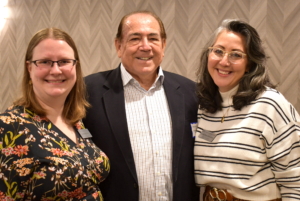
Dr. Benjamín Durán of CVHEC with Dana Center reps Joan Zoellner and Tammi Perez-Rice at the Oct. 13 Math Task Force convening in Fresno.
Dr. Benjamín Durán, CVHEC executive director, said, “We are proud that our Central Valley community colleges are leaning in on the expertise of their own math experts to figure out the best way to support our students within the guidelines of the legislation.”
AB 1705 — passed in 2022 for implementation July 1, 2024 — expands the provisions established in AB 705 (2017) by explicitly requiring community colleges not only to place students directly into transfer-level English and math courses but also to ensure that students actually enroll in those courses.
The legislation also establishes that for students who need or desire extra academic support, community colleges shall provide access to such support. The new law clarifies that a community college can require students to enroll in additional concurrent support if it is determined that the support will increase the student’s likelihood of passing transfer-level English or math.
Community colleges have been tasked with ensuring they comply with both AB705 and AB1705 designed to strengthen support for student success and increase degree completion.
CVHEC helped start the conversation by bringing together its Math Task Force — made up of representatives from CVHEC community colleges — and other math educators to discuss ideas and options regarding implementation within the Central Valley community college mathematics community last fall.
In three virtual sessions and one in-person convening in 2023, the Math Task Force created a collaborative “Central Valley Approach” to each, said Dr. John Spevak, CVHEC regional coordinator who oversees the consortium’s Math and English Task Forces.
“Now, for the January session, administrators and researchers are joining the Math Task Force to develop data-driven and college-endorsed solutions that help meet the challenge head on and in unity for the best interests of students.”
The fall inaugural sessions were facilitated by two Dana Center representatives who will return to Fresno for the Jan. 26 convening: Joan Zoellner, M.A., who is the lead for the Dana Center’s Launch Years Initiative; and Dr. Tammi Perez-Rice, Postsecondary Course Program specialist.
Dr. Erik Cooper, assistant vice chancellor of the California Community College Chancellor’s Office Cooper, also participated in the first virtual session to discuss the recent history of math education reform in California and answer questions as well as present the CCCCO’s AB 1705 Implementation Guide and FAQ webpage.
“With the passage of AB 705 then later 1705 – all designed to strengthen support for student success – CVHEC has been moving full steam ahead in assuring that our member colleges and their feeder high schools have a good understanding of the seemingly turbulent waters of the legislation,” Durán said.
Strand breakdown:
- Validating prerequisites — quantitative and qualitative: creating a Central Valley collaborative approach which would help make a strong case with the state. Point person: NATHAN CAHOON, Taft College math professor.
- Designing Precalculus for 2025: An effective single-course prerequisite for Calculus 1 (especially valuable if the state allows in 2025-26 only one prerequisite course for Calculus 1). Point person: JEREMY BRANDL, Fresno City College math professor.
- Math support outside and inside the classroom: What’s working best in the Central Valley, including math lab centers, tutoring, embedded tutoring, supplemental instruction, etc. Point person: SHELLEY GETTY, Taft College math professor.
- Building an AB 1705 campus team: Who needs to be on the team? Math and English professors, IR/IT staff, counselors, administrators, etc. How does it best function? Point person: MARIE BRULEY, Merced College dean of Science, Technology, Engineering, and Math (STEM).
- Guided self-placement: Helping ensure with the best possible questionnaire that students are taking the right math class when they start college. Point person: JAY THOMAS, West Hills College Lemoore math professor.
(Links to recordings of the two previous sessions are available below).
REGISTER – “The CVHEC Way to Math Success — Implementing AB1705” (Jan. 26, 2024)
EVENT AGENDA For questions: centralvalleyhec@gmail.com.
For media inquiries: Tom Uribes 559.348.3278 (text msg) or cvheccommunications@mail.fresnostate.edu
SEE:
- Previous sessions recordings:
CVHEC “AB1705 in the Central Valley” Webinar with Dr. Erik Cooper Oct. 6, 2023
MTF meeting Nov. 17 (10 a.m. session)
MTF meeting Nov. 17 (1 p.m. session)
- Coverage of the fall sessions:
Math Task Force begins discussion of AB1705 implementation – Nov. 17 next (with Oct. 13 photo gallery).
CVHEC Math Task Force meets in-person Oct. 13 for AB 1705 follow-up
NEWS RELEASE – CVHEC Math Task Force: Impactful legislation (AB 1705) Convenings Oct. 6 & 13
- The CCCCO’s AB 1705 Implementation Guideand FAQ webpage.
- The CVHEC Math Task Force
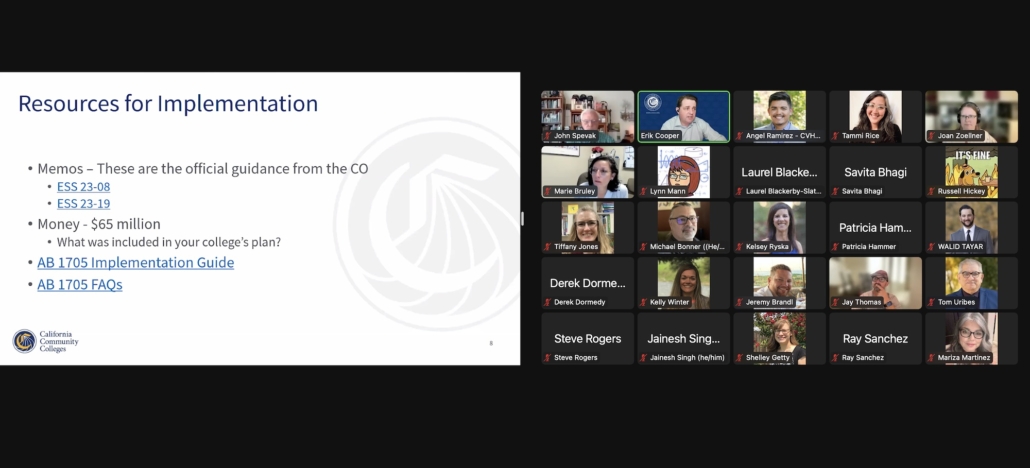
Dr. Erik Cooper of the California Community Colleges Chancellor’s Office zoomed into the Oct. 6 CVHEC Math Task Force session to address AB1705 implementation.
MEMBER NEWS: West Hills College Lemoore breaks ground for Visual Arts/Applied Sciences Bldg.
Dr. Kristen Clark (second from right), chancellor of the West Hills Community College District and chair of the CVHEC board, leads the ceremonial ground-breaking crew at the Lemoore campus.
Construction is underway at CVHEC member West Hills College Lemoore for a new Visual Arts & Applied Sciences (VAAS) building with a groundbreaking ceremony held Dec.1.
 This state-of-the-art, 44,382-square-foot facility will serve as a hub for laboratory classrooms, career technical education programs, and nursing and health careers, addressing the growing demand for high-paying jobs in the local community.
This state-of-the-art, 44,382-square-foot facility will serve as a hub for laboratory classrooms, career technical education programs, and nursing and health careers, addressing the growing demand for high-paying jobs in the local community.
The VAAS building is set to be a cornerstone in the college’s mission to provide students with cutting-edge educational opportunities and practical skills. Modern laboratories will offer students the chance to gain hands-on experience in various fields. At the same time, dedicated spaces for career technical education and health career programs will ensure that the curriculum is aligned with local industry needs, preparing students for in-demand jobs and contributing to the region’s healthcare workforce.
“This new building is another significant step forward in our commitment to delivering high-quality education and training opportunities to our students,” said James Preston, president of West Hills College Lemoore and CVHEC board member.
“The VAAS building will feature an innovative blend of educational programs in the areas of Health Careers, Information Technology, and Visual Arts that will empower our student and community and enhance our capacity to meet local industry demands.”
In an interview with ABC30 at the event, Dr. Kristen Clark, chancellor of the West Hills Community College District and chair of the CVHEC board, said, “We’re thrilled because this will be the first two-story other than the Golden Eagle Arena on campus.”
See West Hills College Lemoore story
See ABC30 story: https://abc30.com/west-hills-college-lemoore-location-visual-arts-applied-science-golden-eagle-arena/14128992/

